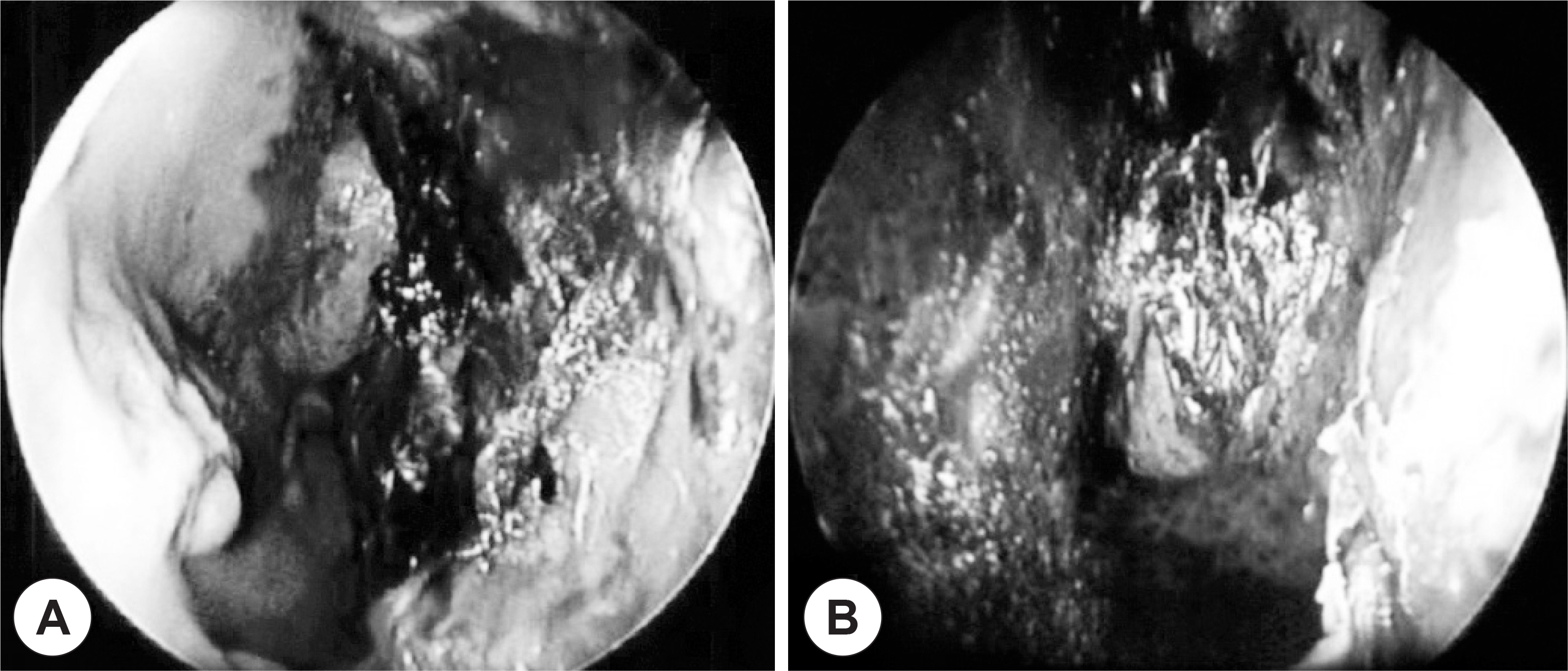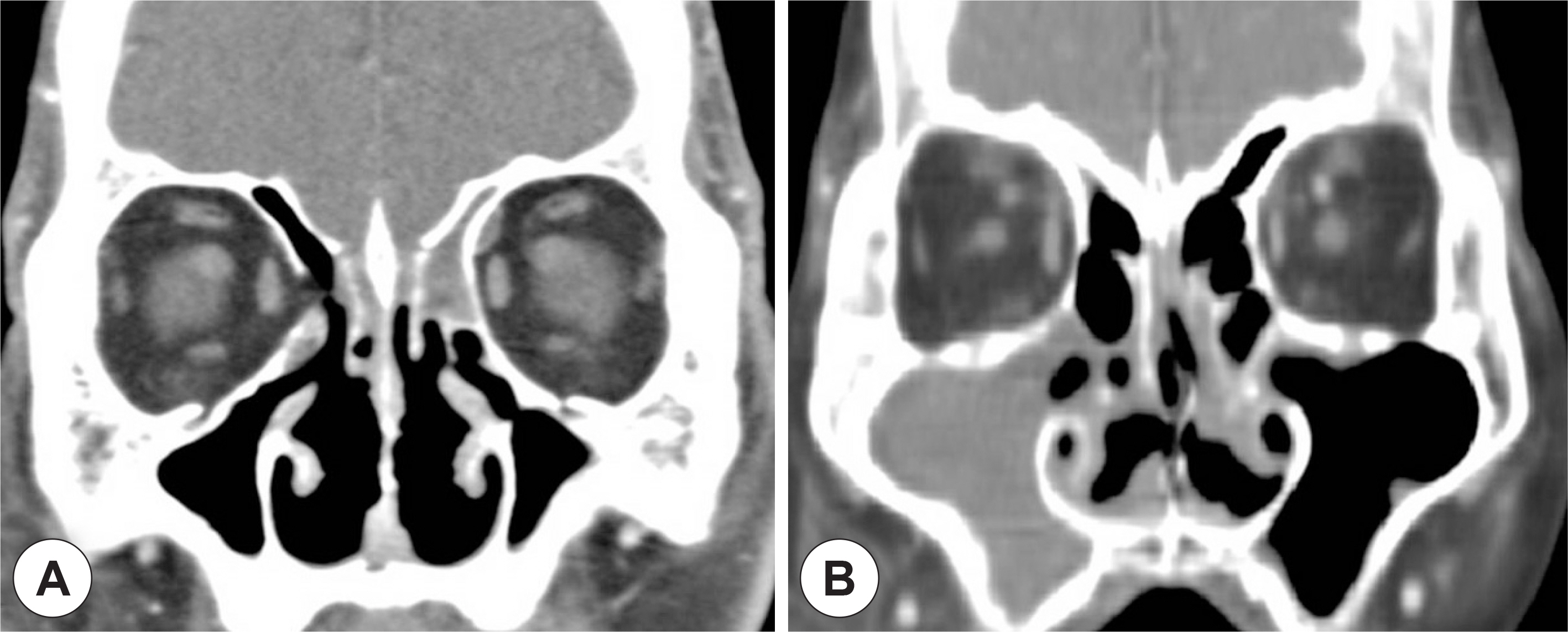J Rhinol.
2015 May;22(1):55-58. 10.18787/jr.2015.22.1.55.
Two Cases of Rhinocerebral Mucormycosis
- Affiliations
-
- 1Department of Otolaryngology-Head & Neck Surgery, Gil Medical Center, Gachon University of Medicine and Science, Incheon, Korea. d0ramong@hanmail.net
- KMID: 2297557
- DOI: http://doi.org/10.18787/jr.2015.22.1.55
Abstract
- Mucormycosis is a rare opportunistic fungal infection. The most common infection site is the paranasal sinuses, although it can also occur in the lungs and skin. The fungus adheres to tissue membranes and forms thrombi, causing ischemia and hemorrhagic necrosis. Rhinocerebralmucormycosiscan occurin the nose, but mightrapidly spread to the orbit and intracranium. Therefore, prompt and aggressive treatment is required. However, because of its low incidence, few reported cases have focused on accompanying disease, proper treatment period, and disease progression. Herein, we report two cases of rhinocerebralmucormycosiswith a brief literature review.
Keyword
MeSH Terms
Figure
Reference
-
References
1). Mantadakis E, Samonis G. Clinical presentation of zygomycosis. Clin Microbiol Infect. 2009; 15(15):15–20.
Article2). Ferguson BJ. Mucormycosis of the nose and paranasal sinuses. Otolaryngol Clin North Am. 2000; 33(2):349–65.
Article3). Do NY, Lee JH, Dong GW. Clinical study of rhinocerebral mucormycosis. Korean J Otolaryngol. 2005; 48(10):1228–34.4). Ogawa T, Takezawa K, Tojima I, Shibayama H, Kouzaki H, Ishida H, et al. Successful treatment of rhino-orbital mucormycosis by a new combination therapy with liposomal amphotericin B and micafungin. Auris Nasus Larynx. 2012; 39(2):224–8.
Article5). Roden MM, Zaoutis TE, Buchanan WL, Knudsen TA, Sarkisova TA, Schaufele RL, et al. Epidemiology and outcome of zygomycosis: a review of 929 reported cases. Clin Infect Dis. 2005; 41(5):634–53.
Article6). Pelton RW, Peterson EA, Patel BCK, Devis K. Successful treatment of rhino-orbital mucormycosis without exenteration: the use of multiple treatment modalities. Ophthal Plast Reconstr Surg. 2001; 17(1):62–6.7). Peterson KL, Wang M, Canalis RF, Abemayor E. Rhinocerebral mucormycosis: evolution of the disease and treatment options. Laryngoscope. 1997; 107(7):855–62.
Article8). Viterbo S, Fasolis M, Garzino-Demo P, Griffa A, Boffano P, Laguin-ta C, et al. Management and outcomes of three cases of rhinocerebral mucormycosis. Oral Surg Oral Med Oral Pathol Oral Radiol Endod. 2011; 112(6):69–74.
Article9). Bethge WA, Schmalzing M, Stuhler G, Schumacher U, Krober SM, Horger M, et al. Mucormycosis in patients with hematologic malignancies: an emerging fungal infection. Haematologica. 2005; 90:22.10). Ali S, Ahmad I. Mucormycosis causing palatal necrosis and orbital apex syndrome. J Coll Physicians Surg Pak. 2005; 15(3):182–3.11). Vessely MB, Zitsch RP 3rd, Estrem SA, Renner G. Atypical presentations of mucormycosis in the head and neck. Otolaryngol Head Neck Surg. 1996; 115(6):);. 573–7.
Article12). Fischer EW, Toma A, Fischer PH, Cheesman AD. Rhinocerebral mucormycosis. Use of liposomal amphotericin B. J Laryngol Otol. 1991; 105(7):575–7.13). Warwar RE, Bullock JD. Rhino-orbital-cerebral mucormycosis: a review. Orbit. 1998; 17(4):237–45.
Article14). Kim J, Fortson JK, Cook HE. A fatal outcome from rhinocerebral mucormycosis after dental extractions: a case report. J Oral Maxillofac Surg. 2001; 59(6):693–7.
Article15). Blitzer A, Lawson W, Meyers BR, Biller HF. Patient survival factors in paranasal sinus mucormycosis. Laryngoscope. 1980; 90(4):635–48.
Article16). O'Neill BM, Alessi AS, George EB, Piro J. Disseminated rhinocerebral mucormycosis: a case report and review of literature. J Oral Maxillofac Surg. 2006; 64(2):326–33.17). Scheckenbach K, Cornely O, Hoffmann TK, Engers R, Bier H, Chak-er A, et al. Emerging therapeutic options in fulminant invasive rhinocerebral mucormycosis. Auris Nasus Larynx. 2010; 37(3):322–8.
Article18). Jung SH, Kim SW, Park CS, Song CE, Cho JH, Lee JH, et al. Rhi-nocerebal mucormycosis: consideration of prognostic factors and treatment modality. Auris Nasus Larynx. 2009; 36(3):274–9.





